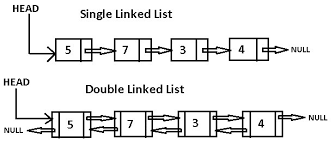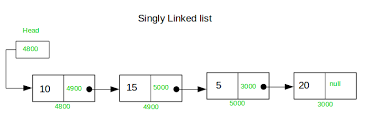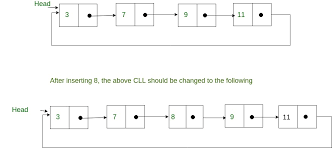Linked List
Linked List is a very commonly used linear data structure which consists of group of nodes in a sequence. Each node holds its own data and the address of the next node hence forming a chain like structure.
Linked Lists are used to create trees and graphs.

Advantages of Linked List
- Linkedlist is dynamic in nature which means it can expand in constant time. It does not have to create a new array as dynamic array does.
- Insertion and deletion operations can be easily implemented.
- Stacks and queues can be easily executed.
- Linked List reduces the access time.
Disadvantages of Linked List
- The memory is wasted as pointers require extra memory for storage.
- No element can be accessed randomly; it has to access each node sequentially.
- Reverse Traversing is difficult in linked list.
Where to use Linked List
- Linked lists are used to implement stacks, queues, graphs, etc.
- Linked lists let you insert elements at the beginning and end of the list.
- In Linked Lists we don’t need to know the size in advance.
When to use Linked List
- When you insert and delete elements often from a list.
There are 3 different implementations of Linked List available, they are:
- Singly Linked List
- Doubly Linked List
- Circular Linked List
Singly Linked List
Singly linked lists contain nodes which have a data part as well as an address part i.e. next, which points to the next node in the sequence of nodes.
The operations we can perform on singly linked lists are insertion, deletion and traversal.

@ToString
@NoArgsConstructor
@AllArgsConstructor
@Data
public class Customer {
private String firstName;
private String lastName;
private String email;
}
@ToString
@Data
public class SingleNode {
private Customer data;
private SingleNode next;
public SingleNode(Customer data) {
this(data, null);
}
public SingleNode(Customer data, SingleNode next) {
this.data = data;
this.next = next;
}
}
@NoArgsConstructor
@Data
public class MySingleLinkedList {
int size = 0;
private SingleNode head;
private SingleNode tail;
public MySingleLinkedList(SingleNode head) {
append(head);
}
/**
* add to end of list<br>
* 1. If the Linked List is empty then we simply, add the new Node as the Head of the Linked List.<br>
* 2. If the Linked List is not empty then we find the last node, and make it' next to the new Node, hence making
* the new node the last Node.
*
* Time complexity of append is O(n) where n is the number of nodes in the linked list. Since there is a loop from
* head to end, the function does O(n) work. This method can also be optimized to work in O(1) by keeping an extra
* pointer to the tail of the linked list.
*/
public void append(SingleNode node) {
if (node == null) {
return;
}
if (this.head == null) {
this.head = node;
this.tail = node;
} else {
this.tail.setNext(node);
this.tail = node;
}
size++;
}
/**
* append to front of list<br>
* 1. The first Node is the Head for any Linked List.<br>
* 2. When a new Linked List is instantiated, it just has the Head, which is Null.<br>
* 3. Else, the Head holds the pointer to the first Node of the List.<br>
* 4. When we want to add any Node at the front, we must make the head point to it.<br>
* 5. And the Next pointer of the newly added Node, must point to the previous Head, whether it be NULL(in case of
* new List) or the pointer to the first Node of the List.<br>
* 6. The previous Head Node is now the second Node of Linked List, because the new Node is added at the front.<br>
*/
public void prepend(SingleNode node) {
if (node == null) {
return;
}
if (this.head == null) {
this.head = node;
} else {
node.setNext(this.head);
this.head = node;
}
size++;
}
/**
* add at position of list
*/
public void add(int index, SingleNode node) {
if (node == null) {
return;
}
int count = 0;
SingleNode currentNode = this.head;
if (this.head.equals(currentNode)) {
/*
* adding to the head
*/
node.setNext(currentNode);
this.head = node;
} else if (this.tail.equals(currentNode)) {
this.tail.setNext(node);
this.tail = node;
}
SingleNode previous = null;
while (currentNode.getNext() != null) {
if (index == count) {
break;
}
previous = currentNode;
currentNode = currentNode.getNext();
count++;
}
node.setNext(currentNode);
previous.setNext(node);
size++;
}
/**
* is empty?
*/
public boolean isEmpty() {
return size <= 0 || this.head == null;
}
/**
* exist? search by email
*/
public boolean existByEmail(String email) {
if (email == null || email.length() <= 0) {
return false;
}
if (this.head == null) {
return false;
} else {
SingleNode currentNode = this.head;
/**
* if email not found, keep checking the next node<br>
* when email is found, break out of while loop
*/
while (!currentNode.getData().getEmail().equalsIgnoreCase(email.toLowerCase())) {
/**
* next is null, so email is not found
*/
if (currentNode.getNext() == null) {
return false;
}
currentNode = currentNode.getNext();
}
return true;
}
}
/**
* get node on index
*/
public SingleNode get(int index) {
if (index < 0 || index >= size) {
throw new IllegalArgumentException("index out of bounds");
}
if (index == 0) {
return this.head;
} else if (index == (size - 1)) {
return this.tail;
} else {
int count = 0;
SingleNode currentNode = this.head;
while (currentNode.getNext() != null) {
currentNode = currentNode.getNext();
count++;
if (index == count) {
break;
}
}
return currentNode;
}
}
/**
* remove node base on index<br>
* 1. If the Node to be deleted is the first node, then simply set the Next pointer of the Head to point to the next
* element from the Node to be deleted.<br>
* 2. If the Node is in the middle somewhere, then find the Node before it, and make the Node before it point to the
* Node next to it.<br>
*/
public void removeAt(int index) {
if (index < 0 || index >= size) {
throw new IllegalArgumentException("index out of bounds");
}
if (index==0) {
this.head = this.head.getNext();
return;
}
int count = 1;
SingleNode previous = this.head;
SingleNode currentNode = this.head.getNext();
SingleNode next = null;
while (count < index) {
previous = currentNode;
currentNode = currentNode.getNext();
next = currentNode.getNext();
count++;
}
if (currentNode.equals(this.tail)) {
this.tail = previous;
this.tail.setNext(null);
} else {
// drop currentNode
previous.setNext(next);
}
}
/**
* remove all<br>
* set head to null
*/
public void removeAll() {
this.head = null;
this.tail = null;
}
/**
* print out list
*/
public void printList() {
if (this.head == null) {
System.out.println("list is empty");
}
int count = 0;
SingleNode node = this.head;
while (node != null) {
System.out.println("index: " + count);
System.out.println("data: " + node.getData().toString());
node = node.getNext();
if (node == null) {
System.out.println("tail: " + tail.getData().toString());
System.out.println("end of list\n");
}
System.out.println("\n");
count++;
}
}
}
Doubly Linked List
In a doubly linked list, each node contains a data part and two addresses, one for the previous node and one for the next node.

@AllArgsConstructor
@ToString
@Data
public class DoubleNode {
private DoubleNode prev;
private Customer data;
private DoubleNode next;
public DoubleNode(Customer data) {
this(null, data, null);
}
}
@NoArgsConstructor
@Data
public class MyDoubleLinkedList {
int size = 0;
private DoubleNode head;
private DoubleNode tail;
public MyDoubleLinkedList(DoubleNode head) {
append(head);
}
/**
* add to end of list<br>
* 1. If the Linked List is empty then we simply, add the new Node as the Head of the Linked List.<br>
* 2. If the Linked List is not empty then we find the last node, and make it' next to the new Node, hence making
* the new node the last Node.
*/
public void append(DoubleNode node) {
if (node == null) {
return;
}
if (this.head == null) {
this.head = node;
this.tail = node;
} else {
DoubleNode currentNode = this.head;
while (currentNode.getNext() != null) {
currentNode = currentNode.getNext();
}
// order doesn't matter, as long as the last operation is tail=node
this.tail.setNext(node);
node.setPrev(this.tail);
this.tail = node;
}
size++;
}
/**
* append to front of list<br>
* 1. The first Node is the Head for any Linked List.<br>
* 2. When a new Linked List is instantiated, it just has the Head, which is Null.<br>
* 3. Else, the Head holds the pointer to the first Node of the List.<br>
* 4. When we want to add any Node at the front, we must make the head point to it.<br>
* 5. And the Next pointer of the newly added Node, must point to the previous Head, whether it be NULL(in case of
* new List) or the pointer to the first Node of the List.<br>
* 6. The previous Head Node is now the second Node of Linked List, because the new Node is added at the front.<br>
*/
public void prepend(DoubleNode node) {
if (node == null) {
return;
}
if (this.head == null) {
this.head = node;
} else {
// order doesn't matter, as long as the last operation is head=node
this.head.setPrev(node);
node.setNext(this.head);
this.head = node;
}
size++;
}
/**
* add at position of list
*/
public void add(int index, DoubleNode node) {
if (node == null) {
return;
}
int count = 0;
DoubleNode currentNode = this.head;
if (index == 0) {
node.setNext(currentNode);
this.head = node;
} else if (index == (size - 1)) {
this.tail.setNext(node);
this.tail = node;
} else {
DoubleNode previous = null;
while (currentNode.getNext() != null) {
if (index == count) {
break;
}
previous = currentNode;
currentNode = currentNode.getNext();
count++;
}
node.setNext(currentNode);
previous.setNext(node);
}
size++;
}
/**
* is empty?
*/
public boolean isEmpty() {
return size <= 0 || this.head == null;
}
/**
* exist? search by email
*/
public boolean existByEmail(String email) {
if (email == null || email.length() <= 0) {
return false;
}
if (this.head == null) {
return false;
} else {
DoubleNode currentNode = this.head;
/**
* if email not found, keep checking the next node<br>
* when email is found, break out of while loop
*/
while (!currentNode.getData().getEmail().equalsIgnoreCase(email.toLowerCase())) {
/**
* next is null, so email is not found
*/
if (currentNode.getNext() == null) {
return false;
}
currentNode = currentNode.getNext();
}
return true;
}
}
/**
* get node on index
*/
public DoubleNode get(int index) {
if (index < 0 || index >= size) {
throw new IllegalArgumentException("index out of bounds");
}
if (index == 0) {
return this.head;
}
if (index == 0) {
return this.head;
} else if (index == (size - 1)) {
return this.tail;
} else {
int count = 0;
DoubleNode currentNode = this.head;
while (currentNode.getNext() != null) {
currentNode = currentNode.getNext();
count++;
if (index == count) {
break;
}
}
return currentNode;
}
}
/**
* remove node base on index<br>
* 1. If the Node to be deleted is the first node, then simply set the Next pointer of the Head to point to the next
* element from the Node to be deleted.<br>
* 2. If the Node is in the middle somewhere, then find the Node before it, and make the Node before it point to the
* Node next to it.<br>
*/
public void remove(int index) {
if (index < 0 || index >= size) {
throw new IllegalArgumentException("index out of bounds");
}
int count = 0;
if (index == 0) {
this.head = this.head.getNext();
this.head.setPrev(null);
} else if (index == (size - 1)) {
this.tail = this.tail.getPrev();
this.tail.setNext(null);
} else {
DoubleNode previous = null;
DoubleNode currentNode = this.head;
DoubleNode next = null;
while (currentNode.getNext() != null) {
if (index == count) {
break;
}
previous = currentNode;
currentNode = currentNode.getNext();
next = currentNode.getNext();
count++;
}
previous.setNext(next);
next.setPrev(previous);
}
}
/**
* remove all<br>
* set head to null
*/
public void removeAll() {
this.head = null;
this.tail = null;
}
/**
* print out list
*/
public void printList() {
if (this.head == null) {
System.out.println("list is empty");
}
int count = 0;
DoubleNode node = this.head;
while (node != null) {
System.out.println("index: " + count);
System.out.println("prev: " + ((node.getPrev() != null) ? node.getPrev().getData().toString() : ""));
System.out.println("current: " + node.getData().toString());
System.out.println("next: " + ((node.getNext() != null) ? node.getNext().getData().toString() : ""));
node = node.getNext();
if (node == null) {
System.out.println("tail: " + tail.getData().toString());
System.out.println("end of list\n");
}
System.out.println("\n");
count++;
}
}
}
Circular Linked List
In circular linked list the last node of the list holds the address of the first node hence forming a circular chain.

Time Complexity
| Data Structure | Time Complexity | Space Complexity | |||||||
|---|---|---|---|---|---|---|---|---|---|
| Average | Worst | Worst | |||||||
| Access | Search | Insertion | Deletion | Access | Search | Insertion | Deletion | ||
| Singly-Linked List | Θ(n) |
Θ(n) |
Θ(1) |
Θ(1) |
O(n) |
O(n) |
O(1) |
O(1) |
O(n) |
| Doubly-Linked List | Θ(n) |
Θ(n) |
Θ(1) |
Θ(1) |
O(n) |
O(n) |
O(1) |
O(1) |
O(n) |
- add() – appends an element to the end of the list. So it only updates the tail node, therefore O(1) constant-time complexity.
- add(index, element) – in average runs in O(n) time
- get() – searching for an element takes O(n) time
- remove(element) – to remove an element, only pointers have to be updated. This operation is O(1).
- remove(index) – to remove an element by index, we first need to find it, therefor the overall complexity is O(n)
- contains() – also has O(n) time complexity